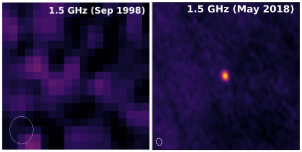Credit X-ray: NASA/CXC/Univ. of Cambridge/J. Sisk-Reynés et al.;
Radio: NSF/NRAO/VLA;
Optical: PanSTARRS
JPEG (194.9 kb) Large JPEG (3.1 MB)- Tiff (52.8 MB)
Radio: NSF/NRAO/VLA;
Optical: PanSTARRS
JPEG (194.9 kb) Large JPEG (3.1 MB)- Tiff (52.8 MB)
H1821+643 is a quasar powered by a supermassive black hole,
located about 3.4 billion light years from Earth. Astronomers used
/about/ to determine the spin of the black hole in H1821+643, making it
the most massive one to have an accurate measurement of this fundamental
property, as described in our press release. Astronomers estimate the actively growing black hole
in H1821+643 contains between about three and 30 billion solar masses,
making it one of the most massive known. By contrast the supermassive
black hole in the center of the Milky Way galaxy weighs about four
million suns.
This composite image of H1821+643 contains X-rays from Chandra (blue) that have been combined with radio data from NSF's Karl G. Jansky Very Large Array (red) and an optical
image from the PanSTARRS telescope on Hawaii (white and yellow). The
researchers used nearly a week's worth of Chandra observing time, taken
over two decades ago, to obtain this latest result. The supermassive
black hole is located in the bright dot in the center of the radio and
X-ray emission.
Because a spinning black hole
drags space around with it and allows matter to orbit closer to it than
is possible for a non-spinning one, the X-ray data can show how fast
the black hole is spinning. The spectrum — that is, the amount of energy
as a function wavelength — of H1821+643 indicates that the black hole
is rotating at a modest rate compared to other, less massive ones that
spin close to the speed of light. This is the most accurate spin
measurement for such a massive black hole.
Why is the black hole in H1821+432 spinning only about half as fast
as the lower mass cousins? The answer may lie in how these supermassive
black holes grow and evolve. This relatively slow spin supports the idea
that the most massive black holes like H1821+643 undergo most of their
growth by merging with other black holes, or by gas being pulled inwards
in random directions when their large disks are disrupted.
Supermassive black holes growing in these ways are likely to often
undergo large changes of spin, including being slowed down or wrenched
in the opposite direction. The prediction is therefore that the most
massive black holes should be observed to have a wider range of spin
rates than their less massive relatives.
On the other hand, scientists expect less massive black holes to
accumulate most of their mass from a disk of gas spinning around them.
Because such disks are expected to be stable, the incoming matter always
approaches from a direction that will make the black holes spin faster
until they reach the maximum speed possible, which is the speed of
light.
A paper describing these results appears in the Monthly Notices of the Royal Astronomical Society and is available at https://arxiv.org/abs/2205.12974
The authors are Julia Sisk-Reynes, Christopher Reynolds, James
Matthews, and Robyn Smith, all from the Institute of Astronomy at the
University of Cambridge in the UK.
NASA's Marshall Space Flight Center manages the Chandra program. The
Smithsonian Astrophysical Observatory's Chandra X-ray Center controls
science operations from Cambridge, Massachusetts, and flight operations
from Burlington, Massachusetts.
Fast Facts for H1821+243:
Scale: Image is about 6.4 arcmin (5.6 million light-years) across.
Category: Black Holes, Groups & Clusters of Galaxies
Coordinates (J2000): RA 18h 21m 57.40s | Dec +64° 20´ 37.0"
Constellation: Draco
Observation Date: 5 observations Jan 17 to Feb 9, 2001
Observation Time: 158 hours 16 minutes (6 days, 14 hours, 16 minutes)
Obs. ID: 1599, 2186, 2310, 2311, 2418
Instrument: ACIS
References: Sisk-Reynés, J. et al., 2022, MNRAS, 514, 2568; arXiv:2205.12974.
Color Code: X-ray: blue; Radio: red; Optical: red, green, blue
Distance Estimate: About 3.4 billion light-years (z=0.299)
Source: NASA’s Chandra X-ray Observatory






























